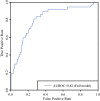Gastric Cancer Peritoneal Carcinomatosis Risk Score
- PMID: 31346896
- PMCID: PMC6925067
- DOI: 10.1245/s10434-019-07624-0
Gastric Cancer Peritoneal Carcinomatosis Risk Score
Abstract
Background: Gastric cancer (GC) peritoneal carcinomatosis (PC) is associated with a poor prognosis. Although grade, histology, and stage are associated with PC, the cumulative risk of PC when multiple risk factors are present is unknown. This study aimed to develop a cumulative GCPC risk score based on individual demographic/tumor characteristics.
Methods: Patient-level data (2004-2014) from the California Cancer Registry were reviewed by creating a keyword search algorithm to identify patients with gastric PC. Multivariable logistic regression was used to assess demographic/tumor characteristics associated with PC in a randomly selected testing cohort. Scores were assigned to risk factors based on beta coefficients from the logistic regression result, and these scores were applied to the remainder of the subjects (validation cohort). The summed scores of each risk factor formed the total risk score. These were grouped, showing the percentages of patients with PC.
Results: The study identified 4285 patients with gastric adenocarcinoma (2757 males, 64.3%). The median age of the patients was 67 years (interquartile range [IQR], 20 years). Most of the patients were non-Hispanic white (n = 1748, 40.8%), with proximal (n = 1675, 39.1%) and poorly differentiated (n = 2908, 67.9%) tumors. The characteristics most highly associated with PC were T4 (odds ratio [OR], 3.12; 95% confidence interval [CI], 2.19-4.44), overlapping location (OR 2.27; 95% CI 1.52-3.39), age of 20-40 years (OR 3.42; 95% CI 2.24-5.21), and Hispanic ethnicity (OR 1.86; 95% CI 1.36-2.54). The demographic/tumor characteristics used in the risk score included age, race/ethnicity, T stage, histology, tumor grade, and location. Increasing GCPC score was associated with increasing percentage of patients with PC.
Conclusion: Based on demographic/tumor characteristics in GC, it is possible to distinguish groups with varying odds for PC. Understanding the risk for PC based on the cumulative effect of high-risk features can help clinicians to customize surveillance strategies and can aid in early identification of PC.
Conflict of interest statement
The authors declare that they have no conflict of interest.
Figures
Comment in
-
ASO Author Reflections: Using the Gastric Cancer Peritoneal Carcinomatosis Risk Score to Inform Surveillance and Treatment.Ann Surg Oncol. 2020 Jan;27(1):248-249. doi: 10.1245/s10434-019-08000-8. Epub 2019 Oct 28. Ann Surg Oncol. 2020. PMID: 31659634 No abstract available.
References
-
- Noone AM HN, Krapcho M, Miller D, Brest A, Yu M, Ruhl J, et al (eds). SEER Cancer Statistics Review, 1975–2015, based on November 2017 SEER data submission, posted to the SEER web site April; 2018. https://seer.cancer.gov/csr/1975_2015/. Accessed 12 Jan 2019.
-
- Seyfried F, von Rahden BH, Miras AD, et al. Incidence, time course, and independent risk factors for metachronous peritoneal carcinomatosis of gastric origin: a longitudinal experience from a prospectively collected database of 1108 patients. BMC Cancer. 2015;15:73. doi: 10.1186/s12885-015-1081-8. - DOI - PMC - PubMed
MeSH terms
LinkOut - more resources
Full Text Sources
Medical
Miscellaneous



